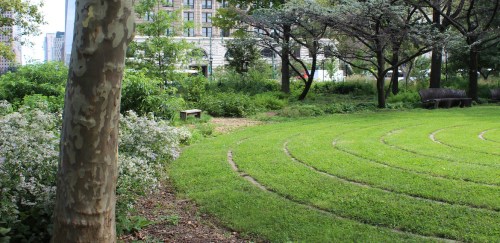If the movie Labyrinth means anything to you, you may think these ancient structures are a trick to be solved. In the film, after wishing for her younger brother to be taken away, Jennifer Connelly’s character has just 13 hours to navigate a fantasy world and solve a creepy labyrinth puzzle to save him and defeat David Bowie’s mullet-donning villain. In reality, the mesmerizing patterns of a labyrinth don’t evoke terror or stress at all—just the opposite, in fact. For centuries, labyrinths have served as a tool for guidance, centering, and calm. Rooted in ancient cultural traditions, labyrinth walking is one practice that can benefit your well-being by combining movement-based meditation and mindfulness.
Experts in This Article
Master of Yoga from International Sivannda Yoga Vedenta Centre, in India, and master practitioner at Banyan Tree Veya Phuket
What is a labyrinth walking meditation?
A labyrinth walking meditation consists of entering a labyrinth, following its path to the center, and coming back the way you came. This journey is symbolic. According to Rajesh Thazhe Thatathil, master practitioner at Banyan Tree Veya Phuket, the labyrinth “represents a journey to our own center, with an intentional possibility of reflecting on the values that guide our lives.” He adds that labyrinth walking is an active form of meditation that allows a person to be quiet and focus internally by integrating the body with the mind and spirit.
Labyrinths appear in many cultures and have played a role in spiritual contemplation for thousands of years. They’ve been the site of rituals, ceremonies, and pilgrimages, and come in many styles such as Medieval and Baltic. One of the best known examples of this is the labyrinth in the Chartres Cathedral in France, which dates back to the 13th century and is thought to echo Greek mythology and symbolize fear, hope, and the human journey toward each.
The mesmerizing, unicursal pattern that defines a labyrinth is key to its benefits. According to Jeny Mathis, Veriditas certified labyrinth facilitator at Serenbe Yoga + Body Works in Chattahoochee, Georgia, many labyrinths echo sacred geometry, or the natural patterns that appear in nature. Think of the wonders of a snail’s shell, or the rings in a tree’s trunk. Following this pattern is thought to be the path to some greater understanding. “It is opening up the creative and the intuitive part of yourself,” says Mathis.

It’s key to note that unlike in the 1986 film, the point of the labyrinth isn’t to confuse or trick you—as Mathis notes, a labyrinth isn’t a maze. A maze is a puzzle designed to fool you and requires logic and analysis to navigate, while the only decision-making involved in labyrinth walking is whether to enter or not. “You are putting one foot in front of the other and following a circuitous path, and because it’s non-linear and it follows sacred geometry, you don’t have to make decisions about where to go,” she says.
The benefits of a labyrinth walking
The stress-relieving benefits of meditation in general are well-known, but movement meditations can be especially helpful for those who have trouble concentrating while staying still and meditating. These practices combine the benefits of walking with those of meditation, to create an extra sense of calm. Studies have shown that mindful walking can help those who are stressed feel calm; one randomized, controlled trial found that those who undertook a mindful walking program over the course of four weeks showed markedly less psychological distress compared to those who didn’t.
Another small study published in the Medicines journal that involved 30 people and specifically focused on labyrinth walking found that it was a physical, emotional, and sensory experience for the participants. Meanwhile a review for the International Journal of Yogic, Human Movement and Sports Sciences found that while it’s physiological benefits needed further study, labyrinth walking imparted mostly positive psychological benefits to its participants.
How to do a labyrinth walking meditation
So where can you find a labyrinth to try this? One method is to enter your zip code, country, or city into the Worldwide Labyrinth Locator to find publicly accessible labyrinths. The database, which is maintained by The Labyrinth Society and Veriditas, contains about 6,250 labyrinths. One such example of a public labyrinth is the Battery Labyrinth in Manhattan, which is located in a public park and consists of seven rings. If you don’t live near a public labyrinth, Thatahil says you can practice a mindful walking meditation on any circular path that leads to a center. The key point here, he says, is “to detach the mind and focus on the present path to calmness.”

There’s no right or wrong way to do this, and you determine the pace and frequency of labyrinth walks. However, Mathis has a method she calls the “four R’s” to help guide the process when she facilitates labyrinth walking meditations. Try using this model as a rough guide when walking a labyrinth if you’re just getting started, and feel free to adjust once you get more comfortable.
How to do a labyrinth walking meditation, using the 4 R’s
1. Remember
Before you enter the labyrinth, Mathis recommends that you take a quick pause to consider your mental state and being. This step is about “having an openness to having your own experience, and maybe some gratitude for what got you to that particular point in your life,” says Mathis. This is a good time to eschew anything weighing on you in the moment, and to take a couple deep breaths to prepare for the meditation.
2. Release
At this point you’ve entered the labyrinth and are following its path. As you walk, Mathis advises “giving yourself permission to be open and let your heart release and let go” of anything giving you pause or preoccupying your mind like any questions you want answers to or fears or loose thoughts. Focus on the path you’re traveling and of course, and don’t check your phone if it’s in your pocket.
3. Receive
You’ve reached the center of the labyrinth, which is “a place for reflection and prayer and to receive whatever is there for you,” says Mathis. Pause and reflect on what you’re feeling and thinking. Some labyrinths may have space for you to sit or lie down in the center, and you should do that if you feel comfortable. Take deep breaths, and stay in the center for as long or as little as you want.
4. Return
When you are satisfied with your time in the center, follow the path you just traveled to exit the labyrinth. Mathis says this walk, or the return, is an opportunity to take whatever wisdom, peace, or guidance you received in the center and process it so you can carry it beyond the labyrinth walking meditation.
Sign Up for Our Daily Newsletter
Get all the latest in wellness, trends, food, fitness, beauty, and more delivered right to your inbox.
Got it, you've been added to our email list.










